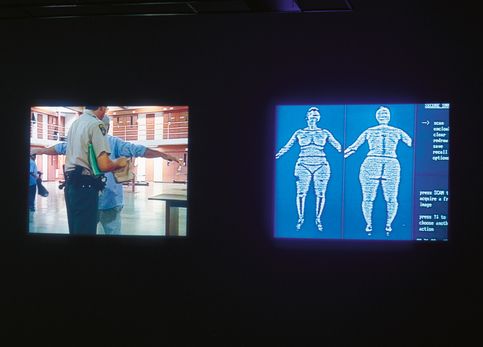Ich glaubte Gefangene zu sehen

Harun Farocki
Ich glaubte Gefangene zu sehen, 2000
Two-channel video installation black and white and color, sound, 25 min (loop) Dimensions variable, projection areas approx. 150 x 200 cm each Director: Harun Farocki Photography: Cathy Lee Crane Produced by: Harun Farocki Filmproduktion, Generali Foundation (Portuguese version, 2001: Pensei que estava a ver Prisinoairos) (Spanish version, 2006: Pensabla Que Veia Presidiarios)
GF0002112.00.0-2000
Artwork text
I thought I was seeing convicts, says Ingrid Bergmann in Rossellini’s Europa 51, after watching female workers in a factory for a day. At the end of the film she is locked away in a psychiatric clinic. Pictures from the Maximum Security Prison in Corcoran, California. The surveillance camera shows a pie-shaped segment, the cement yard where the prisoners are allowed to spend half an hour a day. One prisoner assaults another, whereupon those not involved immediately throw themselves flat on the ground with their arms over their heads. They know what will happen: the guard will call out a warning and then fire rubber bullets. If the prisoners do not stop fighting, he will use live bullets. The pictures are mute; gunpowder smoke drifts across the picture. The camera and the gun are next to one another, the field of vision and the line of fire coincide. It is possible to see how the yard has been constructed in the form of a circular section so that the prisoners are always ex-posed, whether to a gaze or a bullet. A prisoner collapses, usually the one who carried out the assault. Injured, badly injured, sometimes fatally... Prison guards from Corcoran have testified that they sometimes put prisoners from rival gangs (“Mexican Mafia,” “Aryan Brotherhood,” etc.) together in the yard and laid bets on the outcome of the fight. The camera waiting for something to happen is just as anachronistic as the gun. The prisoners are almost naked (they constantly train their muscles) and have nothing except a sense of belong-ing to a clan. Their honor is of more importance to them than their lives. Here, prison creates tribalism. The en-tertainment industry also likes to encourage tribalism, from which it derives its adjectives. The clothing industry provides the trademarks... This picture is of prisoners who fight with one another, even though they know they’ll be shot at. They look like gladiators—and the exercise yard looks like an arena. However, the spectators are missing—it is only the cam-era that is in the position of the Roman proletarians, meant to be kept happy by fights and killings like these. No one is shot dead in Californian prison yards anymore. Instead of a gun, the guards now use a jet of water, mixed with chemicals which in a few seconds render the prisoners unfit to fight. This jet of water blurs the reason why the prisoners used to die. Today, in retrospect, it is also almost impossible to establish why a war was started in the first place. (Harun Farocki)